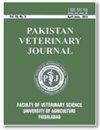日粮中添加酵母对日本鹌鹑生长性能、选定血清参数、肠道形态及致病菌减少的影响
IF 5.4
3区 农林科学
Q1 VETERINARY SCIENCES
引用次数: 7
摘要
本研究的目的是研究饲粮中添加酵母(Saccharomyces cerevisiae)对日本鹌鹑生长性能、部分血清参数、肠道形态和病原体减少的影响。试验300只d龄日本鹌鹑,随机分为5个饲粮组(6个重复,每栏10只)。试验开始(第14天),饲喂不添加酵母的基础饲粮,其余试验组分别在饲料基础上添加0.5、1.5、2.5和3.5%酵母。结果表明,饲粮中添加酵母,尤其是在饲料基础上添加3.5%时,日本鹌鹑的体重最高(P<0.05)。与对照组相比,添加酵母降低了日本鹌鹑血清胆固醇和甘油三酯浓度(P<0.05)。饲粮中添加3.5%酵母与饲粮中添加0.5%酵母或未添加酵母相比,降低了血清中白细胞介素1 β (IL-1 β)、IL-6和TNF-α水平(P<0.05)。与其他处理相比,饲喂3.5%水平的酵母显著增加了十二指肠绒毛高度。饲粮中添加2.5%或3.5%酵母的日本鹌鹑排泄物中大肠杆菌和产气荚膜杆菌CFU数量显著低于未添加酵母的日本鹌鹑(P<0.05)。由此可见,日粮中添加酵母可提高日本鹌鹑的生长速度,其原因是绒毛高度增加,大肠杆菌和产气荚膜杆菌数量减少。©2019 PVJ。版权所有本文章由计算机程序翻译,如有差异,请以英文原文为准。
Effects of Yeast Addition to the Diet of Japanese Quails on Growth Performance, Selected Serum Parameters and Intestinal Morphology as well as Pathogens Reduction
Received: Revised: Accepted: Published online: May 08, 2019 November 03, 2019 November 04, 2019 December 26, 2019 The objectives of the current study were to investigate the impact of dietary yeast (Saccharomyces cerevisiae) supplementation on growth performance, some serum parameters, intestinal morphology and pathogens reduction in Japanese quails. In total, 300 d-old Japanese quails were randomly allocated to 5 dietary groups (6 replicates of 10 Japanese quails per pen). At beginning of the experiment (d 14), Japanese quails fed a basal diet without contain any yeast while, the other treatments provided basal diet plus 0.5, 1.5, 2.5 and 3.5% yeast on feed basis. The results showed that dietary supplementation of yeast, particularly at a level of inclusion of 3.5% on feed basis, resulted in highest BW for Japanese quails (P<0.05). Japanese quails fed diets supplemented with yeast reduced (P<0.05) cholesterol and triglycerides concentrations in serum compared to control. Dietary yeast supplementation at 3.5% reduced (P<0.05) interleukin 1 β (IL-1 β), IL-6 and TNF-α levels in serum compared to those fed dietary yeast at level of 0.5% or fed non supplemented diets. Feeding yeast at level of 3.5% led to increase in duodenal villus height significantly compared to other treatments. Japanese quails fed yeast supplemented diets at 2.5 or 3.5% reduced E. coli (P<0.05) and C. perfringens CFU counts in excreta than those fed non supplemented diet. It is concluded that dietary yeast supplementation of Japanese quails improved growth rate as a result of an increase in villus height and a reduce in the counts of E. coli and C. perfringens. ©2019 PVJ. All rights reserved
求助全文
通过发布文献求助,成功后即可免费获取论文全文。
去求助
来源期刊

Pakistan Veterinary Journal
兽医-兽医学
CiteScore
4.20
自引率
13.00%
发文量
0
审稿时长
4-8 weeks
期刊介绍:
The Pakistan Veterinary Journal (Pak Vet J), a quarterly publication, is being published regularly since 1981 by the Faculty of Veterinary Science, University of Agriculture, Faisalabad, Pakistan. It publishes original research manuscripts and review articles on health and diseases of animals including its various aspects like pathology, microbiology, pharmacology, parasitology and its treatment. The “Pak Vet J” (www.pvj.com.pk) is included in Science Citation Index Expended and has got 1.217 impact factor in JCR 2017. Among Veterinary Science Journals of the world (136), “Pak Vet J” has been i) ranked at 75th position and ii) placed Q2 in Quartile in Category. The journal is read, abstracted and indexed internationally.
 求助内容:
求助内容: 应助结果提醒方式:
应助结果提醒方式:


